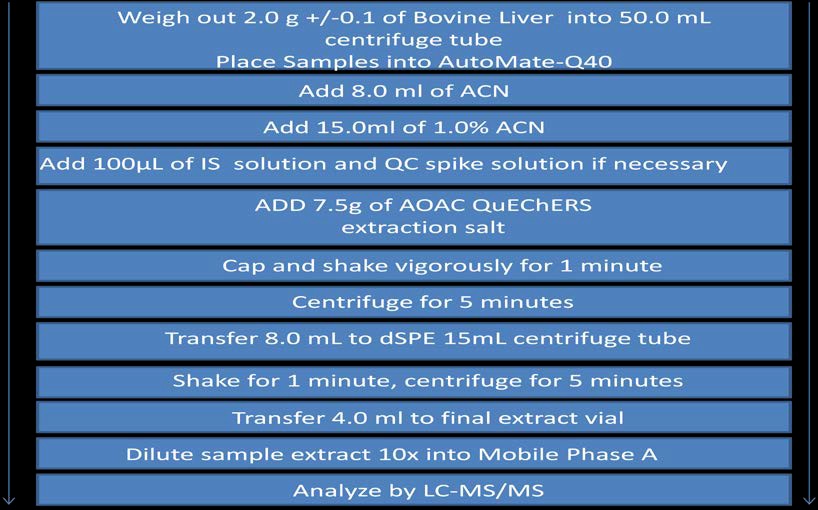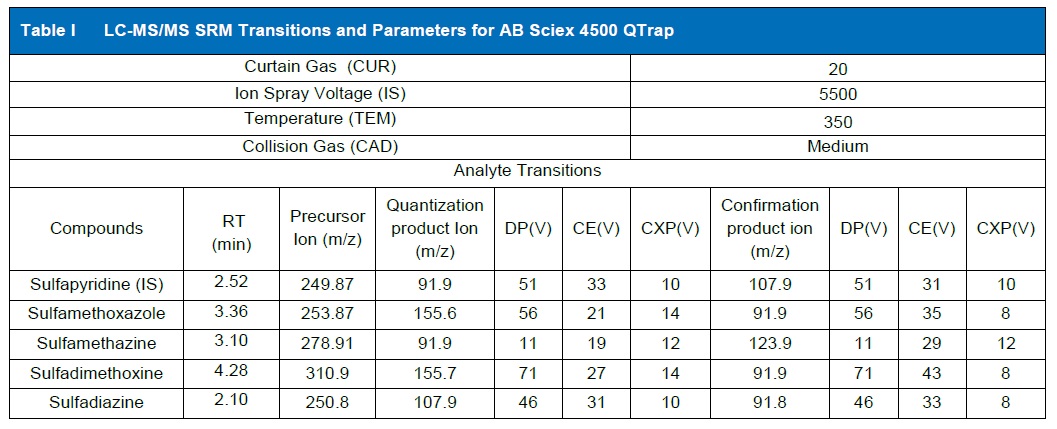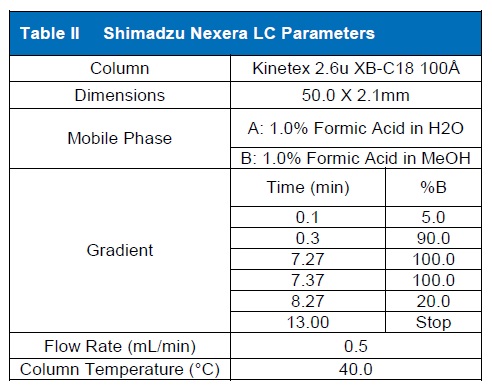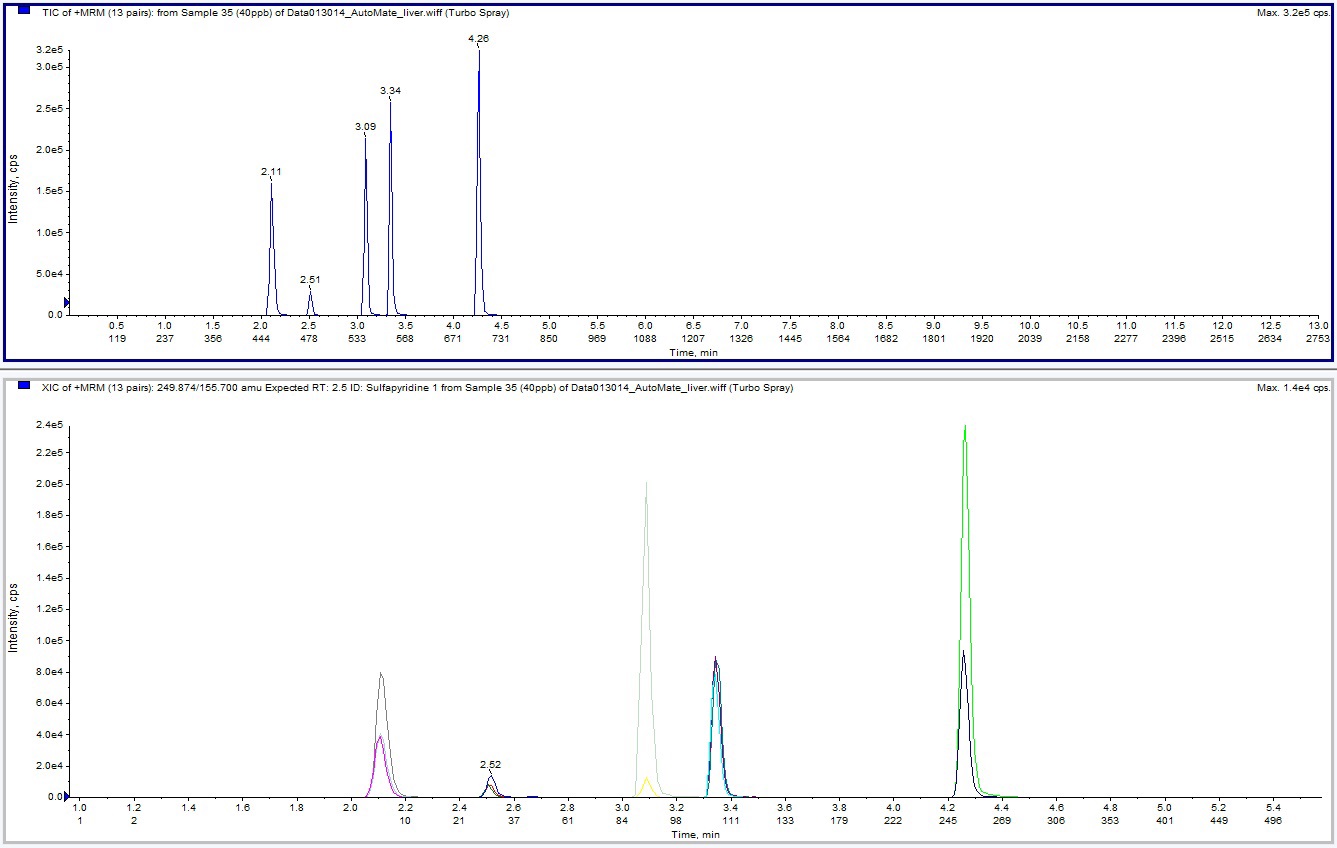Veterinary Drug Residue Analysis
Using the AutoMate™-Q40:
An Automated Solution to
QuEChERS Veterinary Residue; 13-Jun-14 |
|
使用AutoMate™-Q40的動物用藥殘留分析:
一個QuEChERS動物用藥殘留的自動化解決方案 |
|
|
6月13日2014 (中文翻譯:ABDC) |
|
|
Application Note
應用筆記
|
|
Abstract摘要 |
QuEChERS is a Quick-Easy-Cheap-Effective-Rugged-Safe extraction method that
has been developed for the determination of pesticide residues in agricultural
commodities. Since its installment in 2003, QuEChERS has been adapted for
use with many additional matrices.
QuEChERS
是一快速-簡便-廉價-高效-耐用-安全的萃取方法, 已經被發展用來做農產品裏的農藥殘留的測定.自從2003年建立之後,
QuEChERS方法已被調整用於許多增加的基質.
The rise in popularity of this technique and the increase in sample testing
have driven the need for automation of the QuEChERS method to increase
productivity and throughput.
這個技術普及率的上升以及樣品測試的增加, 已經推動了QuEChERS方法的自動化以增加生產力及流通量的需求.
The AutoMate™-Q40 streamlines the QuEChERS method from adding
Acetonitrile(ACN) and buffering salts, shaking, mixing, centrifugating the
sample, transferring to a dispersive solid phase extraction (d-SPE) tube,
measuring and delivering the extract.
從加入乙腈(ACN)和緩衝鹽,搖盪,攪拌,離心分離樣品,移到分散式固相萃取(D-SPE)管,測量和輸送萃取物, AutoMate™-Q40簡化了QuEChERS方法.
The aim of this project is to validate the performance of AutoMate™-Q40 by
monitoring various chemical residues in different matrices. The target residues
will be determined by Liquid Chromatography tandem mass spectrometry.
本計劃的目標是以觀察在不同基質中的化學物質殘留,來驗證AutoMate™-Q40的性能.標的殘留將以液相層析串聯質譜法測定.
Introduction
簡介
With the increasing globalization of the food industry there are consequently
more concerns about food safety. As a result, the number of veterinary drug
residue which must be regulated and monitored has increased.
隨著食品工業的日益全球化有關於食品安全的結果更多的關注. 其結果,動物用藥殘留必須進行調節和監視的數量有所增加.
QuEChERS is a Quick-Easy-Cheap-Effective-Rugged-Safe extraction method
developed in 2003 for the extraction of pesticide residues in agricultural
commodities[1,2,3]. Modifications to the method have expanded
the scope to include many additional matrices and target analytes such as
veterinary drug residues.
QuEChERS
是一個在2003年被發展用來做農產品裏的農藥殘留的快速-簡便-廉價-高效-耐用-安全的萃取方法.
這個方法經過調整後,已經擴大了範圍以包括許多增加的基質和目標分析,如動物用藥殘留等.
With the amounts of samples being required for residue analysis continually
increasing, Teledyne Tekmar has developed the AutoMate™-Q40.
隨著需求做殘留分析的樣品量持序增加,Teledyne公司Tekmar已經開發出AutoMate™-Q40.
This revolutionary system is designed to automate the QuEChERS extraction
workflow, allowing laboratories to be more efficient and timely in meeting their
customer requirements for fast and reliable results.
這一革命性的系統是為了自動化QuEChERS萃取流程而設計,
讓實驗室可以更加有效率地及時地符合其客戶快速及可靠的需求.
This system will help keep sample preparation and the time an analyst spends
on sample prep at a minimum, while producing highly accurate, precise, and
traceable results. 這系統將有助於樣品製備分析工作人員保持花費在樣品製備及時間在最少量,但產出高準確度, 高精密度, 以及可追蹤的結果.
The intent of this study is to evaluate the performance of the AutoMate™-Q40
by monitoring veterinary drug residues in bovine liver. The target compounds
(Sulfonamides) will be analyzed using LC-MS/MS.本研究的目的是經由觀測牛肝臟裏的動物用藥殘留來評估AutoMate™-Q40的性能.
目標化合物(磺胺)將用LC-MS/MS進行分析.
Experiment - Instrument Conditions實驗-儀器條件
Sample Preparation/Extraction
樣品製備/萃取
Bovine liver samples were purchased from a local market in Mason, Ohio. It was
then chopped into fine pieces. Once chopped the sample was placed in the freezer
until the time of analysis. The day of analysis the liver sample was homogenized
meticulously with a food grinder.
牛肝樣品購自於俄亥俄州Mason當地市場.然後將其切成細片.切碎之後的試樣放置在冰箱中直至分析時的時後.分析當天的肝臟樣品用食物研磨機進行精細的均質化.
Figure 1 shows the sample preparation and extraction steps that are needed to
extract the veterinary drug residue from bovine liver. For this analysis, the
AutoMate™-Q40 used QuEChERS AOAC extraction salts (6.0 g MgSO4; 1.5 g
NaAcetate). The AutoMate™-Q40, also, used a version of 900.0 mg
MgSO4, 150.0 mg PSA, and 150.0 mg C-18 for the dSPE cleanup step.
圖1示出了要從牛肝萃取動物用藥殘留所需的樣品製備和萃取步驟.這個分析, AutoMate™-Q40
使用AOAC
的QuEChERS
的萃取鹽(6.0克硫酸鎂, 1.5克醋酸鈉).AutoMate™-Q40也使用一個版本的900.0毫克硫酸鎂,150.0毫克PSA和150.0毫克的C-18於dSPE淨化步驟.
Figure 1 AutoMate™-Q40 Extraction Parameters for Bovine Liver.
圖1 AutoMate™-Q40牛肝萃取參數

Instrumentation and Analytical Conditions
儀器和分析條件
The analysis was conducted on the Shimadzu Nexera LC interfaced to an AB Sciex
4500 QTrap triple-quad mass spectrometer (LC-MS/MS).
分析工作是使用接到一部AB Sciex 4500 QTrap三重四極桿質譜儀(LC-MS/MS)的Shimadzu Nexera的液相層析儀來進行的.
For separation of the compounds of interest, a Phenomenex Kinetex 2.6u XB-C18
100A (50 x 2.1 mm) column was used. Table I and Table II demonstrates the
optimized LC-MS/MS analysis parameters for both the chromatographic separation
and optimal analyte transitions.
對於感興趣的化合物的分離,是用Phenomenex Kinetex 2.6u XB-C18100A(50×2.1mm)分離管柱.表Ⅰ和表Ⅱ中展示了層析分離和最佳的分析物躍遷兩者的最佳的LC-MS/MS分析參數.
Figure 2 shows the scheduled MRM chromatogram spiked at 400.0 μL/L.
圖2示出了在摻入400.0μL/L時的安排下的MRM層析圖.
Table I LC-MS/MS SRM Transitions and Parameters for AB Sciex 4500 QTrap.
表I LC-MS/MS SRM躍遷和AB SCIEX4500 QTrap
的參數

Table II Shimadzu Nexera LC Parameters.
表二
Shimadzu Nexera
液相層析參數

Figure 2 400.0 ng/g Spike of Sulfonamides in Bovine Liver.
圖2 摻入400.0ng/g時的牛肝裏的磺胺類藥物

Experimental Results
實驗結果
Automation of the QuEChERS extraction allows for a fast, easy reliable and
more reproducible extraction.
By using the AutoMate™-Q40, it offers significant labor savings, while improving
the repeatability and consistency between the samples.
QuEChERS萃取的自動化允許一個快速,簡單可靠及更具有再現性的萃取.
AutoMate™-Q40的使用,提供顯著勞動力的節省,同時提高了樣品之間的可重複性和一致性.
A precision and accuracy study was performed on the bovine liver samples using
the AutoMate™-Q40. A 2.0 μg/mL stock solution was used to fortify the liver
samples.
精密度和準確度的研究是用牛肝臟樣品,以AutoMate™-Q40進行的.將2.0μg/ mL的儲備溶液用於加強肝臟的樣品.
Using the AutoMate™-Q40, the system is able to spike the following samples
with 50.0, 100.0 and 250.0 μL of the standard that yielded a 50.0, 100.0, and
250.0 ng/g check samples. These QC samples were quantitated
against a corresponding matrix matched calibration.
使用AutoMate™-Q40,
此系統能夠掺入下列50.0, 100.0
和250.0μL的標準品到樣品中,這產生了50.0, 100.0,
和250.0ng/g
的查檢查用樣品.
這些QC樣品與基質匹配的校正標準樣品對應地進行定量.
Table III Data Table For Veterinary Drug Residues from Bovine Liver Samples.
表三 牛肝樣品的動物用藥殘留的數據表

Table III shows that when using the AutoMate™-Q40 to extract veterinary drug
residues from bovine liver samples, it exhibits recoveries ranging from 74.22%
to 103.57%.
表三顯示,當使用AutoMate™-Q40萃取牛肝樣品的動物用藥殘留時,它表現出從74.22%到103.57%回收率.
These spiking recoveries fell within the recommend values for the Document N˚
Sanco/12495/20114 . This document also states that the %RSD must be below 20%.
By using the AutoMate™-Q40 for the QuEChERS extraction it showed great precision
ranging from 1.17% to 9.4%RSD for the spiked QC samples.
這些標準品掺入的回收率落於
N˚Sanco/12495/20114
文獻的推薦值之內.此文件還指出,
%RSD必須低於20%.
經由AutoMate™-Q40的QuEChERS萃取的使用,在這些掺入標準品的QC樣品,它表現出了從1.17% to 9.4%RSD的極大精準度的範圍.
Conclusion 結論
This study demonstrates the feasibility of automating the QuEChERS extraction
method using the AutoMate™-Q40.
這項研究表明了用AutoMate™-Q40的QuEChERS萃取方法的可行性.
By automating the liquid handing, addition of salt/buffers, sample mixing,
pipetting, and liquid level sensing using the patent pending VialVision™, the
extraction process is faster, more reliable, and easier.
This enables time and labor savings, while improving consistency and re
atability of the extraction. 經由液體處理,鹽/緩衝液添加,樣品混合,移液的自動化, 以及採用正在申請專利的VialVision™液位感測,萃取過程更快,更可靠,更容易.這使能節省時間和勞力,同時提高了萃取的一致性和可重複性.
As shown above in Table III combined veterinary residues spikes recovered at
89.46% with an average RSD of 4.45%RSD. These numbers indicate
superb precision and accuracy thus validating the performance of the
AutoMate™-Q40 and its use as an excellent analytical tool.
如上表III所示,組合的動物用藥殘留標準品掺入,回收率在89.46%, RSD 4.45%. 這些數字表明了極好的精密度和準確度,因而驗證了AutoMate™-Q40的性能及其作為一個很好的分析工具的使用.
References 參考文獻
1. 1. European Committee for Standardization/Technical Committee CEN/TC275
(2008), Foods of plant origin: Determination of pesticide residues using GC-MS
and/or LC-MS/MS following acetonitrile extraction/ partitioning and cleanup by
dispersive SPE QuEChERS-method.
2. 2. AOCA Official Method 2007.07 Pesticide Residues in Food by Acetonitrile
Extraction and Partitioning with Magnesium Sulfate. Gas Chromatography/Mass
Spectrometry and Liquid Chromatography/Tandem Mass Spectrometry, First Action
2007
3. 3. M. Anastassiades: QuEChERS a mini-multiresidue method for the analysis
of pesticide residues in low-fat products
4. 4. Method Validation and Quality Control Procedure for Pesticide Residues
Analysis in Food and Feed (Document N˚ SANCO/12495/201